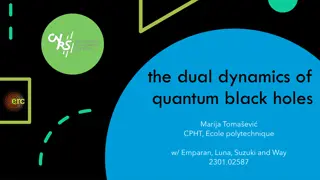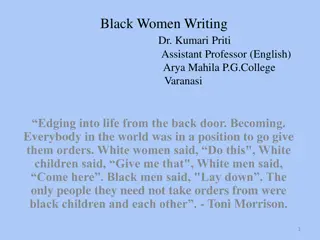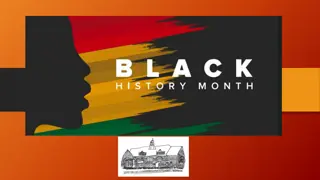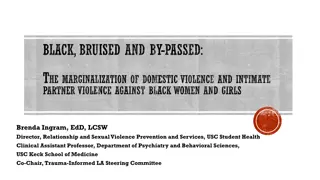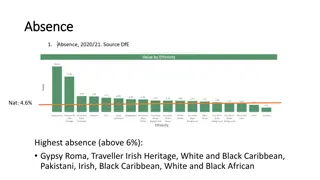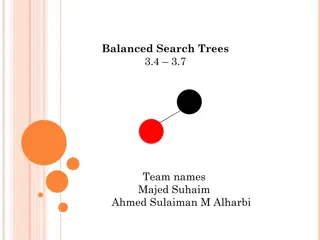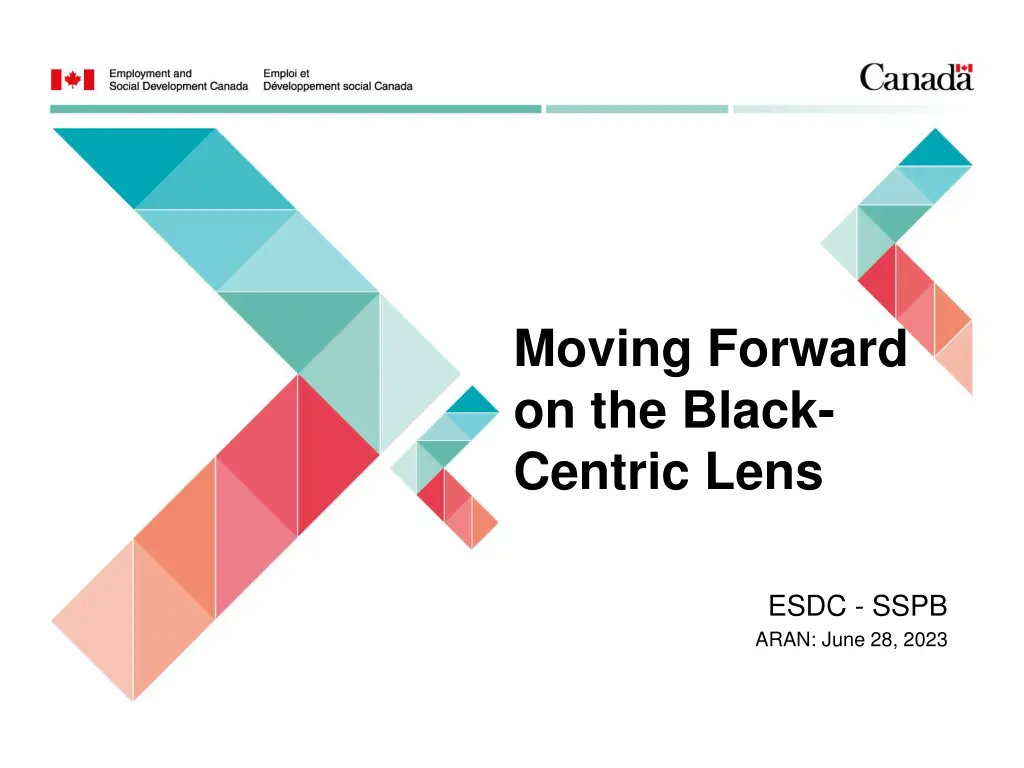
Understanding the Black-Centric Lens at ESDC: Empowering Diversity and Inclusion
Explore the initiative of ESDC to create a Black-Centric Lens, aiming to address anti-Black racism and empower employees to consider the needs of Black Canadians in policymaking. This educational tool breaks down complex histories and barriers, promoting inclusivity and informed decision-making. Discover the impact and progress of the Lens within the department and its commitment to diversity and equity.
Download Presentation

Please find below an Image/Link to download the presentation.
The content on the website is provided AS IS for your information and personal use only. It may not be sold, licensed, or shared on other websites without obtaining consent from the author. If you encounter any issues during the download, it is possible that the publisher has removed the file from their server.
You are allowed to download the files provided on this website for personal or commercial use, subject to the condition that they are used lawfully. All files are the property of their respective owners.
The content on the website is provided AS IS for your information and personal use only. It may not be sold, licensed, or shared on other websites without obtaining consent from the author.
E N D
Presentation Transcript
Moving Forward on the Black- Centric Lens ESDC - SSPB ARAN: June 28, 2023
Safe Space Statement Every single one of us is entitled to work in a safe space: a space free of fear, bullying, harassment and micro-aggressions. We will work together honouring our differences and celebrating the knowledge and expertise we each bring to the table. All participants can expect the same level of respect and safety regardless of race, ethnicity, class, gender, sexual orientation, age, ability, religious affiliation, immigration status, or any other intersections of identity. This is an anti-racist space that respects the experiences of all who are present. 2
Context In late 2020, as part of ESDC s efforts to support the United Nations International Decade for Persons of African Descent and in response to global events that emphasized the need to address anti-Black racism, the Department committed to the former Minister of Families, Children and Social Development, to create a Black-Centric Lens (the Lens) under the Gender- based Analysis Plus framework to equip employees with knowledge and resources to help them address the disparities facing diverse and intersectional Black communities. Following significant intra and inter-departmental engagement efforts along with engagement with external organizations, the Black Centric Lens was developed as an internal resource for all employees to use to better consider the needs and perspectives of Black Canadians in their work. This work also supports the Clerk s Call to Action on Anti-Racism, Equity, and Inclusion in the Federal Public Service by creating an educational tool to help all employees learn more about anti-black racism. 3
Moving forward on the Black-Centric Lens Much of Black history is often difficult to uncover and the Lens shows the extent to which anti-Black history is deeply rooted in Canada. The Lens breaks down a complex and complicated topic and presents the information in a way that is easy to understand in order to help: ESDC employees better understand the history, needs and lived experiences of the diverse Black Canadian Communities; and The Department make more informed policy, program and service design and delivery decisions. It also supports the advancement of the Gender-based Analysis Plus approach by recognizing the unique barriers faced by many Black peoples including those related to intersectionality. The lens is an ESDC tool and we welcome other departments to leverage the tool and use it as for their own needs based on their situation, mandates, etc. 4
Where we are today The Lens was officially launched on February 22, 2023. ESDC Comms team has created a BCL the Intersection series that are publish regurlaly. The use of the Lens has been piloted by Service Canada Ontario Region s Community Outreach and Liaison team in order to improve service for Black Canadians. The feedback from both working and executive level employees have been positive with an indication that this will help improve their work with Black communities in the future. The lens has gained significant visibility with other departments. The team has presented to Global Affairs, Shared Services Canada and The Canadian Food Inspection Agency. The GBA Plus has created a BCL Ambassador Network to support the work on the implementation of the Lens and have held its first meeting on June 1, 2023. 5
Why create a Black-Centric Lens (BCL)? 1. To emphasize the importance of understanding historical contexts when developing and implementing initiatives that impact Black populations. 2. To understand the demographics and socio-economic conditions of Black populations in Canada, including key drivers of quality-of-life disparities and gaps in research and analysis. 3. To highlight the importance of the lived experiences of Black populations, by emphasizing the recurring concerns voiced by Black-led/serving organizations so that employees are equipped with a basic understanding of the lived experiences of Black Canadians. 4. To equip employees with best practices and key considerations when applying a Black-Centric Lens.
Implementing the Lens at ESDC o Human Resource Services Branch and BEAT: o Collective Community Enrichment Circle - Using a Black-Centric Lens approach, the peer to peer program provides employees the opportunity to make progress on their career path and improve access to networks, tools and resources. o Has created several trainings from a Black Centric lens where each topic is covered using examples from the Black Canadian experience. o Has applied a Black Centric Lens to create the 2022 Design Jam, where questions took a for us and by us perspective. o ESDC Labour Branch is launching a Let s Talk Anti-Black Racism Series that will highlight the Historical context of Black Canadians from the Lens. o Benefits and Integrated Services Branch is Building capacity for learning processes on GBA plus and the BCL to embed these tools at Service Canada. 7
Implementing the Lens at ESDC contd o Learning Branch will use the lens to prepare their consultation session with Canadian youth as part of a new program. o Atlantic region will launch an Ambassador workshops around the BCL for its employees. o Chief Data Office will support the department in the collecting data needed to develop and modify programs and services for racialized Canadians. o Cab Affairs and TbSubs Control Unit have consider adding the BCL as a reference document for all employees when writing TbSubs. 8
Observations and Lessons Learned The Lens must always evolve. Nothing about us, without us - Have you taken into account the historical context, lived experiences and needs of Black Canadians when developing, modifying programs, services and policies? To build a better initiative that is inclusive : you need to be connected with various level of employees involved with programs and operations (working level knowledge to address issue i.e., Analysts, Program Advisor, Team Leader, Citizen Service Specialists - working in silos does not work). The concept of Problem Awareness : The real challenge for organizations is not figuring out What can we do? but rather Are we willing to do it? Understanding Empathy - One way to increase empathy is through exposure and education. WE need a strategy! ESDC is working on creating a corporate commitment around the BCL. There are still a lot of Resistance Lenses fatigue. ESDC is in the midst of a transformation that will continue for years to come. Strong leadership will be necessary to navigate change and sustain team engagement, which are critical to the success of this transformation. 9
Next Steps Leverage in house expertise to develop a train the trainer approach across Branches Implement the Lens across key teams and continue the pilot s project Continue to refine the document over time 10
Set the standard in your workplace. For example: Apply a zero-tolerance practice towards any form of Anti- Black Racism and discriminatory practice towards Black employees and Black Canadians 11
Reflection How can your expertise and the work you do be leveraged to help combating anti- Black racism in our programs, policies and services and in our workplace? 12




